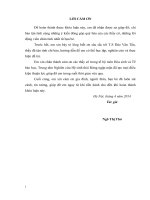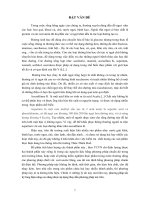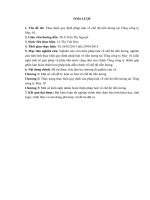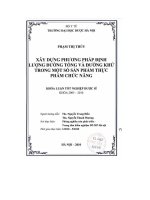định lượng polyphenol tổng
Bạn đang xem bản rút gọn của tài liệu. Xem và tải ngay bản đầy đủ của tài liệu tại đây (195.6 KB, 16 trang )
INTERNATIONAL
STANDARD
ISO
14502-1
Determination of substances
characteristic of green and black tea —
Part 1:
Content of total polyphenols in tea —
Colorimetric method using FolinCiocalteu reagent
Détermination des substances caractéristiques du thé vert et du thé
noir —
Partie 1: Dosage des polyphénols totaux dans le thé — Méthode
colorimétrique utilisant le réactif de Folin-Ciocalteu
Reference number
ISO 14502-1:2005(E)
Copyright International Organization for Standardization
Provided by IHS under license with ISO
No reproduction or networking permitted without license from IHS
© ISO 2005
Licensee=Hong Kong Polytechnic Univ/9976803100
Not for Resale, 08/21/2007 19:58:15 MDT
--````,`,`,`,,,`,,,`,``,``,`,,,-`-`,,`,,`,`,,`---
First edition
2005-03-01
ISO 14502-1:2005(E)
PDF disclaimer
This PDF file may contain embedded typefaces. In accordance with Adobe's licensing policy, this file may be printed or viewed but
shall not be edited unless the typefaces which are embedded are licensed to and installed on the computer performing the editing. In
downloading this file, parties accept therein the responsibility of not infringing Adobe's licensing policy. The ISO Central Secretariat
accepts no liability in this area.
Adobe is a trademark of Adobe Systems Incorporated.
Details of the software products used to create this PDF file can be found in the General Info relative to the file; the PDF-creation
parameters were optimized for printing. Every care has been taken to ensure that the file is suitable for use by ISO member bodies. In
the unlikely event that a problem relating to it is found, please inform the Central Secretariat at the address given below.
© ISO 2005
All rights reserved. Unless otherwise specified, no part of this publication may be reproduced or utilized in any form or by any means,
electronic or mechanical, including photocopying and microfilm, without permission in writing from either ISO at the address below or
ISO's member body in the country of the requester.
ISO copyright office
Case postale 56 • CH-1211 Geneva 20
Tel. + 41 22 749 01 11
Fax + 41 22 749 09 47
Web www.iso.org
Published in Switzerland
ii
Copyright International Organization for Standardization
Provided by IHS under license with ISO
No reproduction or networking permitted without license from IHS
--````,`,`,`,,,`,,,`,``,``,`,,,-`-`,,`,,`,`,,`---
© ISO 2005 – All rights reserved
Licensee=Hong Kong Polytechnic Univ/9976803100
Not for Resale, 08/21/2007 19:58:15 MDT
ISO 14502-1:2005(E)
Contents
Page
Foreword ............................................................................................................................................................ iv
1
Scope...................................................................................................................................................... 1
2
Normative references ........................................................................................................................... 1
3
Principle ................................................................................................................................................. 1
4
Reagents ................................................................................................................................................ 1
5
Apparatus............................................................................................................................................... 3
6
Sampling ................................................................................................................................................ 3
7
Preparation of test samples ................................................................................................................. 3
8
8.1
8.2
8.3
8.4
8.5
8.6
Procedure............................................................................................................................................... 4
General ................................................................................................................................................... 4
Determination of dry matter content ................................................................................................... 4
Test portion ........................................................................................................................................... 4
Extraction of polyphenols .................................................................................................................... 4
Dilution ................................................................................................................................................... 5
Determination ........................................................................................................................................ 5
9
Calculation ............................................................................................................................................. 5
10
10.1
10.2
10.3
Precision ................................................................................................................................................ 6
Interlaboratory test ............................................................................................................................... 6
Repeatability.......................................................................................................................................... 6
Reproducibility ...................................................................................................................................... 6
11
Test report.............................................................................................................................................. 7
Annex A (informative) Gallic acid calibration graph ....................................................................................... 8
Annex B (informative) Results of interlaboratory test .................................................................................... 9
Bibliography ..................................................................................................................................................... 10
--````,`,`,`,,,`,,,`,``,``,`,,,-`-`,,`,,`,`,,`---
iii
© ISOfor2005
– All rights reserved
Copyright International Organization
Standardization
Provided by IHS under license with ISO
No reproduction or networking permitted without license from IHS
Licensee=Hong Kong Polytechnic Univ/9976803100
Not for Resale, 08/21/2007 19:58:15 MDT
ISO 14502-1:2005(E)
Foreword
ISO (the International Organization for Standardization) is a worldwide federation of national standards bodies
(ISO member bodies). The work of preparing International Standards is normally carried out through ISO
technical committees. Each member body interested in a subject for which a technical committee has been
established has the right to be represented on that committee. International organizations, governmental and
non-governmental, in liaison with ISO, also take part in the work. ISO collaborates closely with the
International Electrotechnical Commission (IEC) on all matters of electrotechnical standardization.
International Standards are drafted in accordance with the rules given in the ISO/IEC Directives, Part 2.
The main task of technical committees is to prepare International Standards. Draft International Standards
adopted by the technical committees are circulated to the member bodies for voting. Publication as an
International Standard requires approval by at least 75 % of the member bodies casting a vote.
ISO 14502-1 was prepared by Technical Committee ISO/TC 34, Food products, Subcommittee SC 8, Tea.
ISO 14502 consists of the following parts, under the general title Determination of substances characteristic of
green and black tea:
Part 1: Content of total polyphenols in tea — Colorimetric method using Folin-Ciocalteu reagent
Part 2: Content of catechins in green tea — Method using high-performance liquid chromatography
iv
Copyright International Organization for Standardization
Provided by IHS under license with ISO
No reproduction or networking permitted without license from IHS
© ISO 2005 – All rights reserved
Licensee=Hong Kong Polytechnic Univ/9976803100
Not for Resale, 08/21/2007 19:58:15 MDT
--````,`,`,`,,,`,,,`,``,``,`,,,-`-`,,`,,`,`,,`---
Attention is drawn to the possibility that some of the elements of this document may be the subject of patent
rights. ISO shall not be held responsible for identifying any or all such patent rights.
INTERNATIONAL STANDARD
ISO 14502-1:2005(E)
Determination of substances characteristic of green and black
tea —
Part 1:
Content of total polyphenols in tea — Colorimetric method
using Folin-Ciocalteu reagent
1
Scope
This part of ISO 14502 specifies a method for the determination of the total polyphenol content of leaf tea and
instant tea by a colorimetric assay using Folin-Ciocalteu phenol reagent [4]. It is applicable to both green and
black tea products.
2
Normative references
The following referenced documents are indispensable for the application of this document. For dated
references, only the edition cited applies. For undated references, the latest edition of the referenced
document (including any amendments) applies.
ISO 1572, Tea — Preparation of ground sample of known dry matter content
ISO 3696:1987, Water for analytical laboratory use — Specification and test methods
ISO 7513, Instant tea in solid form — Determination of moisture content (loss in mass at 103 °C)
3
Principle
Polyphenols are extracted with 70 % methanol from a test portion of finely ground leaf tea at 70 °C. Instant
teas are dissolved in hot water with 10 % acetonitrile (volume fraction) added to stabilize the extract. The
polyphenols in the extract are determined colorimetrically using Folin-Ciocalteu phenol reagent. The reagent
contains phospho-tungstic acids as oxidants, which on reduction by readily oxidized phenolic hydroxy groups
yield a blue colour with a broad maximum absorption at 765 nm. This is due to the formation of so-called
tungsten and molybdenum blues. The Folin-Ciocalteu phenol reagent reacts with a wide range of polyphenol
compounds and, although the response can vary with the individual components, selection of gallic acid as a
calibration standard enables useful total polyphenol data to be obtained.
4
Reagents
Use only reagents of recognized analytical grade, unless otherwise specified.
4.1
Water, conforming to grade 1 of ISO 3696:1987.
4.2
Acetonitrile.
4.3
Methanol.
--````,`,`,`,,,`,,,`,``,``,`,,,-`-`,,`,,`,`,,`---
1
© ISO 2005 – All rights reserved
Copyright International Organization for Standardization
Provided by IHS under license with ISO
No reproduction or networking permitted without license from IHS
Licensee=Hong Kong Polytechnic Univ/9976803100
Not for Resale, 08/21/2007 19:58:15 MDT
ISO 14502-1:2005(E)
4.4
Methanol/water extraction mixture, 70 % methanol (volume fraction).
Add 700 ml of the methanol (4.3) to a 1 litre one-mark volumetric flask. Dilute to the mark with water (4.1) and
mix.
4.5
Folin-Ciocalteu phenol reagent, commercially available ready prepared.
It is advisable to check the calibration linearity with respect to gallic acid in order to ascertain the suitability of
the supplied reagent.
4.6
Dilute Folin-Ciocalteu phenol reagent, 10 % (volume fraction).
Using a pipette, transfer 20 ml of Folin-Ciocalteu phenol reagent (4.5) to a 200 ml one-mark volumetric flask.
Dilute to the mark with water and mix.
Prepare fresh reagent solution daily.
To avoid contamination of the concentrated Folin-Ciocalteu reagent, discard any unused dispensed reagent.
4.7
Sodium carbonate solution, 7,5 % (mass concentration).
--````,`,`,`,,,`,,,`,``,``,`,,,-`-`,,`,,`,`,,`---
Weigh (37,50 ± 0,01) g of anhydrous sodium carbonate (Na2CO3) into a 500 ml one-mark volumetric flask.
Add sufficient warm water to half-fill the flask. Swirl to dissolve the sodium carbonate, cool to room
temperature, dilute to the mark with water and mix.
NOTE
This solution will remain stable at room temperature for up to 1 month.
4.8 Gallic acid stock standard solution, corresponding to approximately 1 000 µg/ml of anhydrous gallic
acid.
Weigh (0,110 ± 0,001) g of gallic acid monohydrate (M = 188,14) into a 100 ml one-mark volumetric flask.
Dissolve in water, dilute to the mark and mix.
Prepare a fresh standard solution daily.
NOTE
Gallic acid monohydrate is preferred over anhydrous, due to its greater solubility, reduced hygroscopic
properties and availability of certified reagent grades, e.g. A.C.S., which is used to denote chemicals that meet
specifications outlined by the American Chemical Society. If not known, the moisture content (loss in mass at 103 °C) on a
portion of the standard material should be determined. The concentration of the stock standard solution on a gallic acid
anhydrous basis can then be calculated.
4.9
Gallic acid standard solutions A to E
Using pipettes, transfer the volumes of gallic acid stock standard solution (4.8) given in Table 1 to 100-ml onemark volumetric flasks. Dilute to the mark with water and mix. These dilute standard solutions should be
prepared on the day of use.
Table 1 — Gallic acid dilute standard solutions
Gallic acid standard solution Volume of gallic acid stock solution
2
Nominal concentration of dilute standard
ml
µg/ml
A
1,0
10
B
2,0
20
C
3,0
30
D
4,0
40
E
5,0
50
Copyright International Organization for Standardization
Provided by IHS under license with ISO
No reproduction or networking permitted without license from IHS
© ISO 2005 – All rights reserved
Licensee=Hong Kong Polytechnic Univ/9976803100
Not for Resale, 08/21/2007 19:58:15 MDT
ISO 14502-1:2005(E)
5
Apparatus
Usual laboratory apparatus and, in particular, the following.
5.1
Analytical balance, capable of weighing to an accuracy of ± 0,001 g.
5.2
Water bath, capable of being maintained at 70 °C ± 1 °C.
5.3
Dispenser, for methanol/water extraction mixture (4.4), and set at 5,0 ml.
5.4
Centrifuge, capable of 2 000 Relative Centrifugal Force (R.C.F.) (typically 3 500 r/min).
5.5 Spectrophotometer, set at 765 nm and able to accommodate 10 mm path length cells, preferably in an
automatic flow cell assembly.
5.6
Pipettes, glass or automatic, to cover the volume range for standard and sample extract dilutions.
5.7
One-mark volumetric flasks, of capacities 100 ml, 200 ml, 500 ml, and 1 litre.
5.8
Vortex mixer, for efficient mixing during extraction.
5.9
Extraction tubes, glass, of 10 ml capacity, stoppered and able to withstand being centrifuged.
5.10 Graduated tubes, glass, of 10 ml capacity with 0,1 ml graduations.
As the assay is sensitive to traces of organic impurities, extraction tubes (5.9) and graduated tubes (5.10)
should all be taken through an additional cleaning procedure of washing in approx. 15 % (volume fraction)
nitric acid, followed by rinsing thoroughly in water and drying in an air oven at 100 °C. The use of disposable
plastic tubes as an alternative to the graduated tubes in the final colorimetic assay is recommended, as
additional cleaning has not been found necessary.
6
Sampling
A representative sample should have been sent to the laboratory. It should not have been damaged or
changed during transport or storage.
Sampling is not part of the method specified in this part of ISO 14502. A recommended sampling method is
given in
ISO 1839 for leaf tea, and
ISO 7516 for instant tea.
7
Preparation of test samples
To ensure homogeneity, grind the sample of leaf tea in accordance with ISO 1572 and store samples in wellsealed containers protected from light.
Grinding of instant tea is only required on samples of a coarse granular structure.
--````,`,`,`,,,`,,,`,``,``,`,,,-`-`,,`,,`,`,,`---
3
© ISOfor2005
– All rights reserved
Copyright International Organization
Standardization
Provided by IHS under license with ISO
No reproduction or networking permitted without license from IHS
Licensee=Hong Kong Polytechnic Univ/9976803100
Not for Resale, 08/21/2007 19:58:15 MDT
ISO 14502-1:2005(E)
8
Procedure
8.1
General
If it is required to check whether the repeatability limit (10.2) is met, carry out two single determinations in
accordance with 8.2 to 8.6 under repeatability conditions.
8.2
Determination of dry matter content
Calculate the dry matter content from the moisture content (loss in mass at 103 °C) determined on a portion of
the test sample (Clause 7) in accordance with
ISO 1572 for leaf tea, or
ISO 7513 for instant tea.
8.3
Test portion
8.3.1
Instant tea
Weigh (0,500 ± 0,001) g of the test sample (Clause 7) into a 50 ml one-mark volumetric flask.
8.3.2
Leaf tea
Weigh (0,200 ± 0,001) g of the test sample (Clause 7) into an extraction tube (5.9).
8.4
Extraction of polyphenols
8.4.1
Instant tea
8.4.1.1
Add to the instant tea in the flask (8.3.1) approximately 25 ml of hot water (maximum temperature
60 °C). Mix to dissolve the sample and allow to cool to room temperature.
8.4.1.2
8.4.2
Add 5,0 ml of acetonitrile (4.2). Dilute to the mark with water and mix.
Leaf tea
8.4.2.1
Place the methanol/water extraction mixture (4.4) contained in the dispenser (5.3) in the water
bath (5.2) set at 70 °C, and allow at least 30 min for the extraction mixture to equilibrate.
8.4.2.2
Place the extraction tube containing the sample (8.3.2) in the water bath set at 70 °C. Dispense
5,0 ml of hot methanol/water extraction mixture from 8.4.2.1 into the extraction tube, stopper and mix on the
vortex mixer (5.8).
8.4.2.3
Continue heating the extraction tube in the water bath for 10 min, mixing on the vortex mixer after
5 min and 10 min.
8.4.2.4
Remove the extraction tube from the water bath and allow it to cool to room temperature. Remove
the stopper and place the tube in the centrifuge (5.4) at 3 500 r/min for 10 min.
8.4.2.5
Carefully decant the supernatant into a graduated tube (5.10).
8.4.2.6
Repeat extraction steps 8.4.2.2 to 8.4.2.5. Combine the extracts, make up to 10 ml with cold
methanol/ water extraction mixture (4.4) and mix the contents.
4
Copyright International Organization for Standardization
Provided by IHS under license with ISO
No reproduction or networking permitted without license from IHS
© ISO 2005 – All rights reserved
Licensee=Hong Kong Polytechnic Univ/9976803100
Not for Resale, 08/21/2007 19:58:15 MDT
--````,`,`,`,,,`,,,`,``,``,`,,,-`-`,,`,,`,`,,`---
It is important to mix the samples thoroughly to ensure complete extraction.
ISO 14502-1:2005(E)
8.4.2.7
The extract from 8.4.2.6 is stable for at least 24 h if stored at 4 °C. Allow the extract to attain room
temperature before proceeding with the assay. Resuspension of the small amount of particulate material that
may settle during storage is not necessary.
8.5
Dilution
Using a pipette, transfer 1,0 ml of the sample extract (instant tea extract from 8.4.1.2 or leaf tea extract from
8.4.2.6) into a one-mark 100 ml volumetric flask. Dilute to the mark with water and mix.
8.6
Determination
--````,`,`,`,,,`,,,`,``,``,`,,,-`-`,,`,,`,`,,`---
8.6.1 Using a pipette, transfer 1,0 ml of the gallic acid standard solutions A, B, C, D and E (4.9), in duplicate,
into separate plastic or graduated tubes (5.10).
NOTE
These correspond to approximately 10 µg, 20 µg, 30 µg, 40 µg and 50 µg of anhydrous gallic acid.
8.6.2 Using a pipette, transfer 1,0 ml of water, in duplicate, into separate tubes (5.10). These are reagent
blanks.
8.6.3
Using a pipette, transfer 1,0 ml of diluted sample extract (8.5), in duplicate, into separate tubes.
8.6.4
Using a pipette, add 5,0 ml of dilute Folin-Ciocalteu phenol reagent (4.6) into each tube and mix.
8.6.5 Within 3 min to 8 min after the addition of the dilute Folin-Ciocalteu phenol reagent, pipette 4,0 ml of
sodium carbonate solution (4.7) into each tube. Stopper and mix.
8.6.6 Allow to stand at room temperature for 60 min, and then measure the optical densities in 10-mm path
length cells against water on the spectrophotometer (5.5) set at 765 nm.
8.6.7 The reagent blank (8.6.2) should have an optical density of < 0,010. Higher values indicate
contamination problems from poor quality water, reagents or glassware. It is also important that the sample
optical density be within the calibration range. Repeat the colorimetric assay with an increased dilution (8.5) if
the sample optical density is higher than the 50 µg gallic acid standard E.
9
Calculation
9.1 Calculate, to the nearest 0,1 µg, the mass of anhydrous gallic acid, m, in the 1,0 ml aliquots of the
standard solutions A, B, C, D and E (4.9) taken in 8.6.1, using the formula:
m=
m 0 × V × wDM, std × 10 000
100 × 100
where
m0
is the mass of gallic acid monohydrate, in grams, used to prepare the stock standard solution
(4.8);
V
is the volume of gallic acid stock standard solution, in millilitres, used to prepare the standard
solutions A, B, C, D and E (4.9 );
wDM, std is the dry matter content, expressed as a mass fraction, in percent, of the gallic acid.
9.2 Construct a best-fit linear calibration graph from the mass of anhydrous gallic acid in standards A, B, C,
D and E (4.9 ), as calculated in 9.1, against the gallic acid standard optical densities after subtracting the
reagent blank optical density.
5
© ISO 2005 – All rights reserved
Copyright International Organization for Standardization
Provided by IHS under license with ISO
No reproduction or networking permitted without license from IHS
Licensee=Hong Kong Polytechnic Univ/9976803100
Not for Resale, 08/21/2007 19:58:15 MDT
ISO 14502-1:2005(E)
Obtain the calibration line slope and intercept value. A typical gallic acid calibration graph is given in Annex A.
A linear calibration should be obtained. Calculate the calibration line slope value to the nearest 0,000 1 for use
in subsequent calculations. The linear calibration should also have an intercept close to the origin. Intercept
values on the optical density y-axis > ± 0,04 should be investigated. For example, check the gallic acid
moisture content, standard preparation or pipette calibration.
The total polyphenol content, wT, expressed as a percentage by mass on a sample dry matter basis, is given
by the formula:
wT =
( D sample − Dintercept ) × V sample × d × 100
S std × m sample × 10 000 × wDM, sample
where
is the optical density obtained for the sample test solution;
Dintercept
is the optical density at the point the best-fit linear calibration line intercepts the y-axis;
Sstd
is the slope obtained from the best-fit linear calibration;
msample
is the mass, in grams, of the sample test portion;
Vsample
is the sample extraction volume, in millilitres (50 ml for instant tea and 10 ml for leaf tea);
d
is the dilution factor used prior to the colorimetric determination (typically 1,0 ml to 100 ml,
thus a dilution factor of 100);
--````,`,`,`,,,`,,,`,``,``,`,,,-`-`,,`,,`,`,,`---
Dsample
wDM, sample
is the dry matter content, expressed as a mass fraction in percent, of the test sample,
determined in accordance with 8.2.
10 Precision
10.1 Interlaboratory test
Details of the interlaboratory test to determine the precision of the method are summarized in Annex B. The
values derived from this interlaboratory test may not be applicable to concentration ranges and matrices other
than those given.
10.2 Repeatability
The absolute difference between two independent single test results, obtained using the same method on
identical test material in the same laboratory by the same operator using the same equipment within a short
interval of time, will in not more than 5 % of cases be greater than the repeatability limit values, r, given in
Table B.1.
10.3 Reproducibility
The absolute difference between two single test results, obtained using the same method on identical test
material in different laboratories with different operators using different equipment, will in not more than 5 % of
cases be greater than the reproducibility limit values, R, given in Table B.1.
6
Copyright International Organization for Standardization
Provided by IHS under license with ISO
No reproduction or networking permitted without license from IHS
© ISO 2005 – All rights reserved
Licensee=Hong Kong Polytechnic Univ/9976803100
Not for Resale, 08/21/2007 19:58:15 MDT
ISO 14502-1:2005(E)
11 Test report
The test report shall specify:
all information necessary for the complete identification of the sample;
the sampling method used, if known;
the test method used, with reference to this part of ISO 14502;
all operating details not specified in this part of ISO 14502, or regarded as optional, together with details
of any incidents which may have influenced the test result(s);
the test result(s) obtained;
if the repeatability has been checked, the final quoted result obtained.
© ISO 2005 – All rights reserved
Copyright International Organization for Standardization
Provided by IHS under license with ISO
No reproduction or networking permitted without license from IHS
--````,`,`,`,,,`,,,`,``,``,`,,,-`-`,,`,,`,`,,`---
Licensee=Hong Kong Polytechnic Univ/9976803100
Not for Resale, 08/21/2007 19:58:15 MDT
7
ISO 14502-1:2005(E)
Annex A
(informative)
Gallic acid calibration graph
X
Content of anhydrous gallic acid, µg/ml
Y
Optical density, 765 nm
y = 0,132x = 0,0113
R2 = 0,998 5
Calibration line slope = 0,013 2
Intercept value = 0,011 3
Figure A.1 — Best-fit linear calibration graph for gallic acid
8
--````,`,`,`,,,`,,,`,``,``,`,,,-`-`,,`,,`,`,,`---
Copyright International Organization for Standardization
Provided by IHS under license with ISO
No reproduction or networking permitted without license from IHS
© ISO 2005 – All rights reserved
Licensee=Hong Kong Polytechnic Univ/9976803100
Not for Resale, 08/21/2007 19:58:15 MDT
ISO 14502-1:2005(E)
Annex B
(informative)
Results of interlaboratory test
An interlaboratory test, carried out in 2001 under the auspices of the International Organization for
Standardization, gave the statistical results (evaluated in accordance with ISO 5725-2) shown in Table B.1.
Table B.1 — Precision data
Green leaf tea
Black leaf tea
Black leaf tea
A
B
C
Number of participating laboratories
23
23
23
Number of accepted test results
20
20
20
Mean total polyphenol content, %
(mass fraction), on a dry matter basis
24,35
18,81
13,95
Repeatability standard deviation, sr
0,332
0,218
0,214
Repeatability coefficient of variation, %
1,36
1,16
1,53
Repeatability limit, r (= 2,8 sr)
0,93
0,61
0,60
Reproducibility standard deviation, sR
1,129
1,186
1,029
Reproducibility coefficient of variation, %
4,64
6,31
7,38
Reproducibility limit, R (= 2,8 sR)
3,16
3,32
2,88
Sample identification
--````,`,`,`,,,`,,,`,``,``,`,,,-`-`,,`,,`,`,,`---
9
© ISO 2005 – All rights reserved
Copyright International Organization for Standardization
Provided by IHS under license with ISO
No reproduction or networking permitted without license from IHS
Licensee=Hong Kong Polytechnic Univ/9976803100
Not for Resale, 08/21/2007 19:58:15 MDT
ISO 14502-1:2005(E)
Bibliography
ISO 1839:1980, Tea — Sampling
[2]
ISO 7516:1984, Instant tea in solid form — Sampling
[3]
ISO 5725-2:1994, Accuracy (trueness and precision) of measurement methods and results — Part 2:
Basic method for the determination of repeatability and reproducibility of a standard measurement
method
[4]
SINGLETON, V.L., ORTHOFER, R. and LAMUELA-RAVENTOS, R.M. Analysis of total phenolics and other
oxidation substrates and antioxidants by means of Folin-Ciocalteu reagent. In: Methods in Enzymology.
Oxidants and Antioxidants, Part A, Lester Packer, ed. (1999) 299, pp. 152-178
--````,`,`,`,,,`,,,`,``,``,`,,,-`-`,,`,,`,`,,`---
[1]
10
Copyright International Organization for Standardization
Provided by IHS under license with ISO
No reproduction or networking permitted without license from IHS
© ISO 2005 – All rights reserved
Licensee=Hong Kong Polytechnic Univ/9976803100
Not for Resale, 08/21/2007 19:58:15 MDT
--````,`,`,`,,,`,,,`,``,``,`,,,-`-`,,`,,`,`,,`---
Copyright International Organization for Standardization
Provided by IHS under license with ISO
No reproduction or networking permitted without license from IHS
Licensee=Hong Kong Polytechnic Univ/9976803100
Not for Resale, 08/21/2007 19:58:15 MDT
--````,`,`,`,,,`,,,`,``,``,`,,,-`-`,,`,,`,`,,`---
ISO 14502-1:2005(E)
ICS 67.140.10
Price based on 10 pages
© ISO 2005 – All rights reserved
Copyright International Organization for Standardization
Provided by IHS under license with ISO
No reproduction or networking permitted without license from IHS
Licensee=Hong Kong Polytechnic Univ/9976803100
Not for Resale, 08/21/2007 19:58:15 MDT









